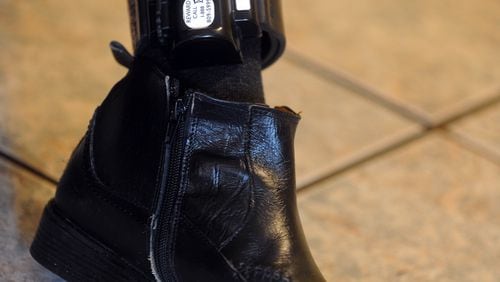Thousands of freed sex offenders listed on a state registry are not classified by the level of risk they pose — despite being required by law — leaving the public with no way of knowing how dangerous they are.
The Georgia Sex Offender Registration Review Board is tasked with gauging whether sex offenders pose almost no risk, are likely to re-offend or are violent predators. But a lack of manpower to do background checks has led to backlog of more than 6,100 offenders who have yet to be labeled, leaving citizens unable to get an accurate picture of the risks posed by sex offenders living in their neighborhoods.
“It’s a problem,” said Vernon Keenan, director of the Georgia Bureau of Investigation which maintains the sex offender registry on the GBI website. “We shouldn’t have unclassified sex offenders. We will never be current under the current practice.”
There are almost 21,100 people on Georgia’s sex offender registry. Nearly 4,200 are still in prison but will soon be released within six months.
But the process of classifying a sex offender is time-consuming and there aren’t enough people. The GBI has eight people, three added in July, who do the criminal background checks for the review board’s four analysts.
Meanwhile, a Fulton County judge recently ruled that the review board itself is unconstitutional — putting the law itself at risk.
Risk to the public
The legal challenges add one more complexity to an already struggling system.
Georgia’s law was enacted to comply with a federal statute, the 2006 Adam Walsh Child Protection and Safety Act, named for the 6-year-old Florida boy who was kidnapped from a shopping mall and later found murdered.
The federal law, also known as the Sex Offender Registration and Notification Act, required a three-tier classification system that the public can access to find out where sexual offenders live.
The state sex offender registry website lists 5,171 as “level one” because they pose little risk to the public. Nearly 2,800 are assigned to “level two” because there is an increased likelihood they will re-offend. And 678 are listed as sexually dangerous predators.
There also are 1,463 offenders who cannot been classified because their crimes occurred before the current law took effect in 2006. (The registry still contains the names of 184 sex offenders who have died but their names have not yet been removed from the list.)
The level assigned to each sex offender is based on details of the crime and staff analysts’ “extensive knowledge on criminal sexual behavior,” said Tracy Alvord, the board’s executive director.
“It’s all we can do to keep up with what’s coming in the door,” Keenan said about the effort to reduce the backlog.
Legal battle ahead
Even as the state struggles to keep the registry somewhat current, the system of classifying the risk level for sex offenders is in jeopardy.
In December, the Georgia Supreme Court will hear the appeal of Fulton Judge T. Jackson Bedford’s ruling that the board is unconstitutional. Bedford said Kenneth Berzett’s constitutional rights were violated when he was classified as a “dangerous sexual predator” on the state registry because it appeared the law was for punishment even beyond the end of a court-ordered sentence.
At the most severe classification, Berzett must wear an ankle monitor for the rest of his life. He has to call the Columbia county deputy assigned to him when the battery dies or he is out of range for the signal to be picked up.
He faces questions when people notice the device. The ankle monitor has to be charged twice a day, which means he “is immobilized at a location with an electrical outlet for at least an hour” each time, Berzett’s attorney, Mark Yurachek, wrote in a court filing.
He has injured himself when the ankle monitor caught on farm equipment while he worked. The law says the ankle monitor will document if a sex offender is anywhere near a crime scene.
“It goes beyond just putting your name somewhere,” Yurachek said. “It’s the government following you everywhere.”
Berzett pleaded guilty 10 years ago to child molestation for inappropriately touching a teenage girl. When he was released from prison he went to a Washington County rehabilitation center and farm run by a faith-based group, Mighty Man Ministries, and he is now the director there.
He learned he was classified as a dangerous sexual predator only after the 14-member board had already decided.
Yurachek said the requirement that Berzett be monitored — and pay for the monitoring — for the rest of his life extended his punishment beyond his sentence.
Bedford agreed with that argument.
“Berzett is thus monitored and controlled in very much the same fashion as if he were on probation or parole,” the judge wrote in his order.
Also, Bedford wrote, wearing the GPS monitoring is “a highly intrusive search” as it will track his movements inside his home as well as out.
Earlier this year, the Georgia Supreme Court ruled on another challenge to how the registry review board operates, deciding that another sex offender was entitled to a court hearing to challenge the risk level the board assigned to him.
“It’s not just child molestation (that gets an offender on the registry) but also public indecency, statutory rape with two teenagers outside the three-year range or the guy who looks at child porn,” said Scott Key, the attorney who argued the other review board case earlier this year.
Key said the information the board uses is one-sided.
“Anything said in police narratives is taken as truth,” Key said. “The offender doesn’t have a role in how they are assessed initially. None of what the sex review board does is in the open.”
The levels assigned to sex offenders
Level 1 — the convicted sex offender has a 4 percent to 13 percent chance of committing another sex crime.
Level 2 — indicates there’s about a 34 percent chance the sex offender will strike again.
Dangerous sexual predator — means there’s a 65 percent chance or greater that the offender will commit more sex crimes.
– Staff writer Jennifer Peebles contributed to this article.
About the Author






